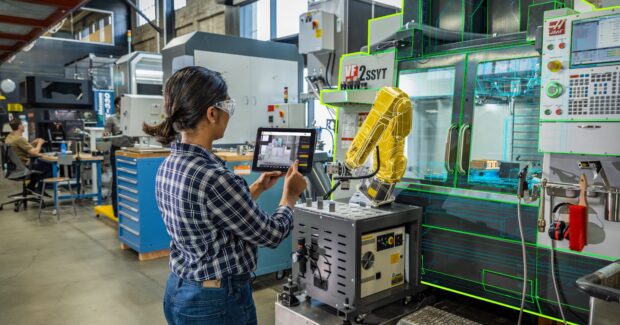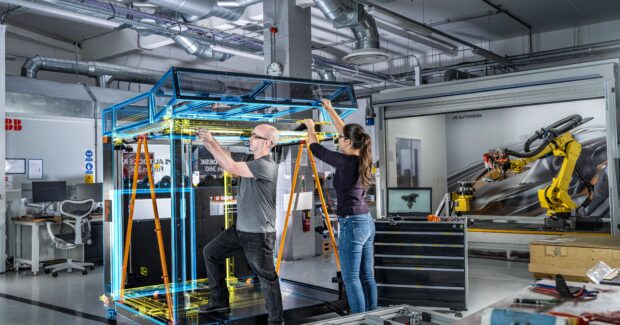State of the Industry: Artificial Intelligence Revolutionizes Manufacturing
The productivity and efficiencies unleashed by AI tools overcome the skepticism that tends to take hold when it comes to using new tech in the slow to adapt manufacturing sector.
Posted: January 15, 2025
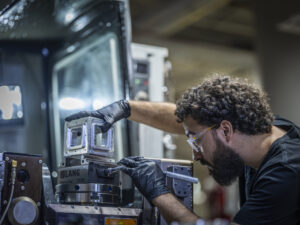
Imagine Artificial Intelligence (AI) tools empowering the design and manufacturing processes in your shop to essentially function with a one-click experience, condensing the various phases of the design-to-make process. Now, imagine the time savings and what it can do for your shop, opening up engineers to work on higher-value functions, tackle backlogs, and work on additional projects.
The manufacturing sector is notoriously slow when it comes to implementing new technologies. However, with AI, the opportunity overcomes skepticism. In fact, 76% — three out of four respondents — to Autodesk’s 2024 State of Design & Make survey stated they trust the use of AI in their industries. (There were more than global 5,000 respondents.)
Metalworkers want to move past the buzz surrounding AI and discover how they can put the applications to use today. They want to understand how it adds real value to operations.
The first thing to keep in mind is that AI is not coming for manufacturing jobs — it will not take the place of workers. Rather, AI is truly a tool, an assistant, to companies involved in metalworking. Not only do the outcomes save time and money but they free up a skilled individual who normally would be punching in numbers to create a stack of drawings, as an example, to foster creativity or innovation (very human traits), or to create additional projects. AI enables a shop to reduce the amount of time a project takes. It allows both engineers and machine operators to address things such as backlog in order to be more productive and profitable.
Fabricating & Metalworking asked a representative of Autodesk Inc. to share insights as to what AI really means for manufacturers; how it adds value to processes; how metalworkers can put AI tools to use now; and what’s next regarding AI tools and functionalities?
Autodesk’s software is focused on design and make for industries such as manufacturing, engineering, construction and others. One of its software products is Fusion, which integrates CAD, CAM, CAE, and PCB into a single cloud-based solution, enabling manufacturers to design and make anything. The connected data increases innovation, and the automated workflows eliminate repetitive tasks.
Unleashing Designs Never Thought Possible
AI-based innovations of the last few years are built on top of foundational automated algorithms that we’ve always had, noted Clinton Perry, senior product marketing manager for Autodesk. “The net combination of those two is clearly driving productivity gains across the board.”
What is most interesting about AI tools in manufacturing is that yes, they solve problems your shop is aware of, but also solve problems your shop has never considered as being a problem. AI is transformative and innovative.
At its recent Autodesk University conference, the company shared “some mind blowing implementations of AI,” Perry noted. One initiative, Project Bernini, is an internal research project that aims to enable users to enter prompts, such as text and images, into an AI system to drive the creation of 3D shapes. So, if you were making sunglasses, for example, you could input several images of sunglasses and tell it to use those images to create a 3D model, and to make it sporty, sleek or what have you.
“The AI algorithm is effectively listening to your text prompts and using that, combined with the seed imagery that you’ve provided to it to create all of these innovative designs that you would never have created if you were doing it yourself,” Perry said. “It’s almost like a form of generative AI, where with a small number of text prompts or image prompts or examples of work you’ve done before, the AI will create almost an infinite number of design variables. So, it’s exposing solutions to you that you could never have accessed if you were just sitting there as a human being designing on a piece of paper or a sketch pad.”
The transformation comes not just through automating a process but “unleashing completely new possibilities you would never have thought of previously,” Perry added.
Uses in the Here and Now
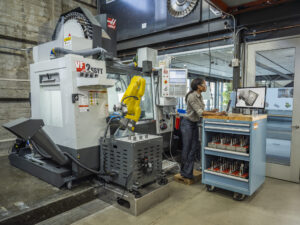
AI at work in metalworking manufacturing processes delivers outcomes such as boosting productivity, improving sustainability, and reducing waste, among numerous other advantages. One of those advantages focuses on the ease of which data is made available throughout your shop, but more importantly, how your shop can utilize the data to drive business success.
At its heart, AI fundamentally tries to do three things, Perry pointed out:
- Augmenting data streams (such as transcribing your voice in a video call and augmenting the video feed of multiple cameras on a video call.)
- Analyzing a large variety of data sets to answer questions such as what, why and how (why is a machine sitting idle for 60% of the day?)
- Automating processes such as an AI-based technology inside software that automates the production of 2D drawings.
AI at work in Autodesk’s signature software, Fusion, for example, goes further than that, Perry stated. An engineer instructs the software to create a set of drawings with a number of “seed dimensions.” This trains the AI algorithm to create the style of drawing you want, and from that point, it will create the entire set of drawings for a particular component or assembly — which, in the case of a complex assembly, could be dozens or even hundreds of pages.
This capability can save a shop more than 80% of typical processing time, which is huge to a manufacturing business. It also frees individuals and teams to create additional projects. The productivity gains “free the human being up to do something that’s more creative, not just sitting there punching numbers into a system and therefore potentially making mistakes,” Perry noted.
The software is also able to analyze sketches and automatically add constraints. CAD modeling benefits from having appropriately constrained sketches in part because these 2D pieces are used to drive the 3D shape. But they really offer the most benefit as the underlying parameters can be used to make changes to the 3D design. For this to work, however, the constraints must be properly defined (or risk the 3D model failing to successfully build).
The role of AI here is to take the guesswork out of the process — automatically analyzing the sketches and adding all the required constraints. This is something that requires considerable time, skill, and expertise to do it manually.
It recognizes intended constraints in a design, such as symmetry or relative dimensions, without possessing the skill set of a design engineer that’s taken years to amass and requiring that engineer to manually define those constraints in the model.
So, if you decide to move a hole in the component’s sketch, say half an inch, and if there is a feature connected to that hole, the feature moves with it, mapping the constraint. It takes time and skill to create those constraints, and it is easy to make errors. AI eliminates the risk of error and automates the completion of those 2D sketching processes, Perry noted. This is a great example of where AI delivers real value.
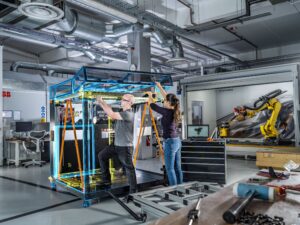
Another example of AI delivering value is seen in Autodesk’s AI tool, Form Explorer, which is focused on automotive manufacturing processes. It enables auto designers to input 2D images of its existing car designs and the AI will learn from the data set, allowing users to add inputs such as creating a slightly sportier version of the brand or creating a particular type of vehicle. The AI tool will create many variants of this design.
Perry said this design process offers more recognizable levers that designers can pull within the system to create a lower shoulder line on the car, or increase the wheel axle length, as examples. What’s key is that these new designs preserve an automaker’s brand aesthetic so that you recognize it as a Toyota, Tesla or what have you. “It is mind blowing in terms of what that’s doing and obviously it’s going to allow those designers to explore many more design iterations that they just wouldn’t have had the time to do previously, Perry said.
With AI-Is the Sky the Limit?
As mentioned above, AI builds on automated algorithms working to remove risk and uncertainties faced by operators on the shop floor, for example. The Autodesk Assistant, which is under development, is an AI agent that responds to natural language questions with natural language answers that use the Autodesk knowledge base, and its partners’ data, as its source.
Soon, the Assistant will not only provide answers to questions but will also trigger the features and capabilities in the Autodesk tool that a user needs in order to complete the steps it recommends.
So, if you are new to the shop floor, or planning to cut a component on a new CNC machine, or cutting new materials you haven’t processed before, there are uncertainties and risks that might lead to damaging the workpiece, fixtures, the machine — or possibly a worker.
With the Assistant software, AI would enable you to search for the best way to machine a part in aluminum; or the best way to cut a part in Inconel. “We have the ability to look at the large data models inside Fusion and access things like cutting feeds and speeds with recommendations from cutting tool suppliers,” Perry said.
Autodesk partners with industry suppliers and other software companies to develop AI functions to completely automate processes, including the generation of NC code, which ordinarily relies on users to input numbers to program a machine to cut a part. Future AI capabilities will enable metalworkers to load the models for parts, then receive suggestions from the AI about what material will be needed, and what machine is needed, to manufacture the part. These suggestions, after being reviewed, tweaked as needed, and approved by the metalworker, will then drive all downstream processes. AI, through a quick analysis, may ultimately be able to determine the most effective ways to program and machine the component with zero human input, Perry pointed out, “so that what once took a skilled user days to program a part, might take a matter of minutes.”
At this point in time, the use of AI has practical uses in the metalworking sector and promises to deliver even more time- and money-saving functionalities. The reality is, Perry noted, that AI tools are not perfect, and they don’t work with every single part. And though the tools are making progress, they aren’t yet capable of driving complex machines such as a 5-axis milling machine.
But consider examples of AI tools that currently assist shops 80% of the way in completing processes, such as with part design, which equates to huge savings. This opens up engineers to work on higher-value projects that may be more profitable.
Beyond improvements in the design process, another consideration with AI tools is the ability to capture the knowledge of the departing super-skilled workforce. The number of people leaving manufacturing compared to the number of people entering the industry is out of balance, which the industry knows all too well. Technologies such as AI help capture the work the departing generation has produced in order to empower the next generation. The power of cloud computing stores and imparts the tribal knowledge that exists within your company to share with the next generation of fabricators and machinists.
Perry shared the challenge and opportunity is to learn to use AI to help your shop keep up with the more-than-enough-work-to-go-around paradigm of manufacturing today.
Using the power of modern computing to capture the good work of past generations, learn from it and build on it, efficiently, in a “not reinvent the wheel” kind of way, is a huge benefit Autodesk sees coming from AI. One thing to note: It really only works well when the system — namely, the massive amounts of data and the required computing power — are in the cloud.
For companies such as Autodesk, the aim is to deploy AI at different levels in the design and make process, where the computer does what it does best – focus on math and algorithms – producing results with one click of a mouse in order to carry out the various phases of the processes. What’s more, because the tools are connected, any change to the downstream processes can almost be updated automatically —naturally, there are limits but there are many things that can be done to streamline downstream processes.
For manufacturers, the opportunity and promise of AI tools outweighs the skepticism normally held by stakeholders.
{sidebar 1}
Manufacturer Builds on Software Platform to Deliver Value
SendCutSend, which provides online custom sheet metal manufacturing as a service, utilizes Autodesk’s Fusion software as its platform, developing a plug-in, an app effectively, to create a successful user experience for its customer base. The company has more than 165 materials in stock to create custom parts in as little as two days.
SendCutSend taps into the open, extensive and expandable platform of Autodesk’s Fusion software.
At SendCutSend’s website, customers upload their STEP, DXF or EPS files and the Fusion system will automatically convert files to a quote of how much it will cost to manufacture that part.
Customers are able to choose from variables, such as whether a CNC machine will be used, if sheet metal bending needs to take place, if painting will be needed afterwards, or if the part is going to be anodized, as examples. “Those sorts of parameters need to be ticked, but at the end of it, there’s a cost,” said Clinton Perry, senior product marketing manager, Autodesk Inc. “If I’m a small mom and pop shop looking to make a bracket, instead of it costing me hundreds or thousands of dollars to make that one part, I can get a part made for the equivalent price as if it were just going to be made in a larger production run, so I’m saving cost. And SendCutSend are able to do that in principle because they’ve built this platform on top of the Fusion interface.”
Perry noted the circle in this process. If the cost estimate of manufacturing a component is too high for a customer, they can see in real time what the savings will be as a result from changes to the design of the part, such as changes to the bend of the radius or changing a fillet radius. “That small change to the design could have a massive impact on the cost of manufacturing that part for you, which obviously saves you money,” he said. “There’s this sort of constant spiral of, is this the right part? Is this the right price?
“You can go through that process and have confidence that at the end of it, the part you get is the best part for your needs and at the right price point,” Perry continued. “And all of that is built on Fusion and AI.”
https://youtu.be/wrhrXlDTl4I?si=inQcIAOA–J0x2YS





